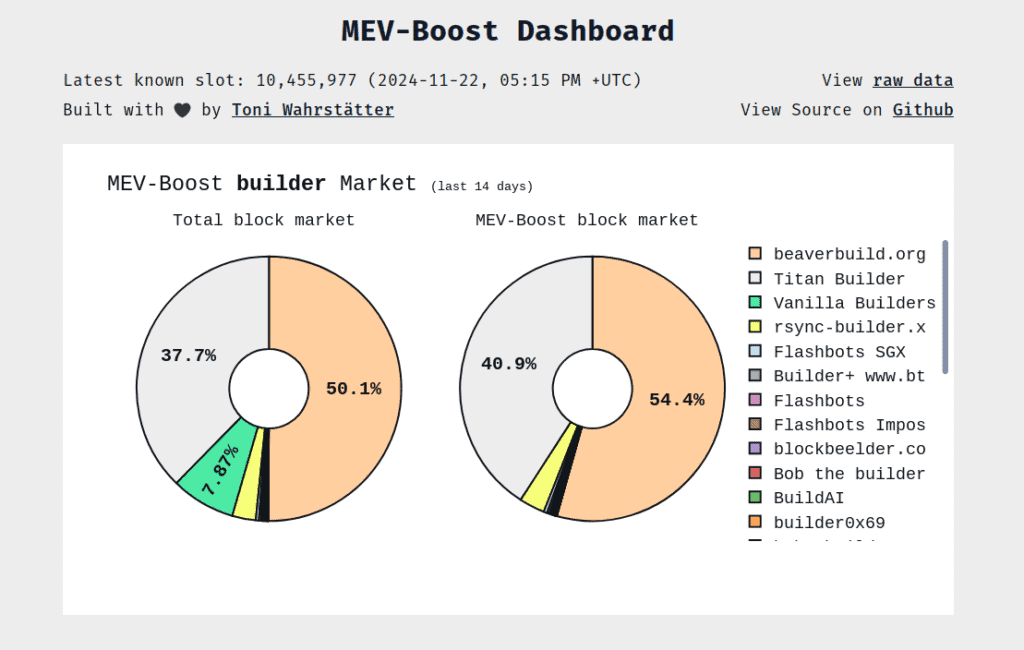
Ethereum developers and community are closely monitoring the increasing centralization of the network, while generating new solutions to this problem.
If Ethereum 2.0 and its Merge in 2022 promised anything, it was to make the Ethereum network a much more secure and decentralized network, taking advantage of its new consensus protocol, Proof of Stake (PoS) integrated into the project. A situation that currently, and from the perspective of the validators, has been partially fulfilled, but from the perspective of the block builders, things change radically, showing an increasing centralization.
And according to the most recent data, we have that, for example, the Coinbase exchange is the largest validator, controlling approximately 12% of the staked ETH, although some claim that this percentage can reach 30%, if the private stake is taken into account. This may or may not worry, after all it is still below the 50% with which they could theoretically manipulate the Ethereum blockchain (although with PoS, that percentage is much more dynamic). But the view from the side of the block builders is much more disturbing, especially because they are the ones who include the transactions, decide their order and then bid in an auction for their block to be included in the chain.
Thus, a single block builder, Beaverbuild, is responsible for building more than half of Ethereum's blocks in September. In fact, 95% of the blocks were built by the two main builders, Beaverbuild and Titan. A piece of information that we can access from the web Mevboost.pics, created by developer and Ethereum Foundation member Toni Wahrstätter. An image that makes very clear the high level of centralization that we see in Ethereum.

Private pools, the great trigger
This trend towards centralization is driven by maximum extractable value (MEV), where block builders reorder transactions to gain an advantage. A situation where dark pools and their private transactions are the main trigger.
Recall that in the past, all pending Ethereum transactions were publicly visible, so block builders would select the transactions and build the blocks. However, in an attempt to prevent others from seeing the transactions, high-frequency bot operators and other traders have established direct relationships with block builders, sending their transactions to them privately.
These transactions are only private in their pending state, as they are issued and queued within these dark pools and the transactions do not reach other pools on the network. Despite this, block builders (e.g. Beaverbuild) can take those transactions within their dark pool and include them in their blocks, earning the fees and carrying out a number of practices that you might consider unfair.
So what seems like an interesting utility for pools and builders is turning into a headache and an unparalleled threat to the network. In fact, recent research from Blocknative found that over half of Ethereum’s gas fees are now paid for these private blocks, and that these blocks account for on average 30% of all blocks in each Ethereum epoch.
A situation warned
The situation that seems “new” has actually been long denounced by the community. In fact, at the beginning of last year in a document published by the Special Mechanisms Group (now part of Consensys), the group highlighted this problem and proposed solutions to address this challenge.
According to the paper, high-frequency traders (HFTs) would want to use private transactions, and the potential benefits mean that the associated block builder can outbid other builders. Specifically, HFTs tend to arbitrage between prices on centralized exchanges (CEXs) like Binance and decentralized exchanges (DEXs) like Uniswap. HFTs want to ensure that their transactions are at the beginning of the block, so they are willing to pay handsomely.
But beyond this, many users and figures in the crypto community made it clear that MEV and the use of Proof of Stake would only increase the centralization of Ethereum: in the end, it turns out they were right.
Beaverbuild and market domination
In any case, the situation is clear, Beaverbuild is the block builder that most centralizes Ethereum. In fact, any player on the Ethereum network who wants to ensure that their transactions are approved quickly has a clear objective: go to Beaverbuild, pay the fee and thereby ensure that they are in the next block. After all, they account for 54% of the winning blocks. And if that doesn't work, they can go to Titan, which controls 40%.
This is undoubtedly an unwanted situation that has led to a response from the community, especially from flashbots, who have set out to create BuilderNet. The goal of this initiative is to distribute control of the block building process more equitably among different operators. With this collaborative approach to block building, BuilderNet seeks to encourage multiple operators to work together to share and process the order flow in a secure manner.
Interestingly, this proposal by Flashbot has the support of Beaverbuild, along with the developers of the Nethermind node, which shows great support for solving this problem. And it is no wonder, let us remember that the vision of organizations such as the SEC on whether Ethereum is or is not an asset, is based on the decentralized nature of its network, so putting this characteristic at risk can put Ethereum in the crosshairs of regulators. Not to mention that centralization and its risks must be avoided by any means possible within a blockchain infrastructure.



